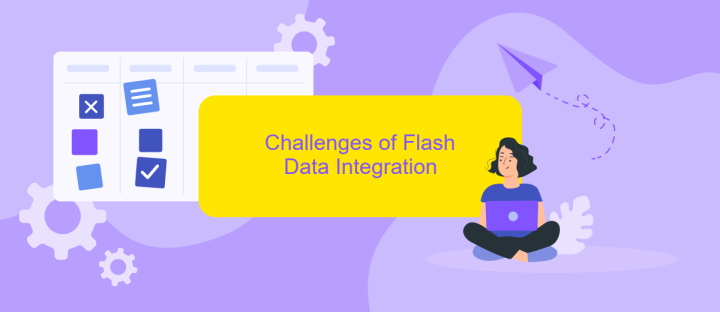Flash Data Integration
Flash Data Integration is revolutionizing the way businesses handle and process data. By enabling real-time data synchronization across various platforms and systems, it ensures that organizations can make informed decisions quickly and efficiently. This cutting-edge technology not only enhances operational efficiency but also provides a competitive edge in today's fast-paced digital landscape. Discover how Flash Data Integration can transform your data management strategies.
Introduction to Flash Data Integration
Flash Data Integration is a crucial aspect of modern data management, enabling seamless and real-time data exchange between disparate systems. This approach ensures that data is consistently up-to-date, enhancing decision-making processes and operational efficiency. With the increasing complexity of IT environments, businesses require robust solutions to handle data integration challenges effectively.
- Real-time data synchronization
- Enhanced data accuracy and consistency
- Improved decision-making processes
- Streamlined operations
- Scalability and flexibility
One of the leading services that facilitate Flash Data Integration is ApiX-Drive. This platform offers a user-friendly interface and powerful tools to automate data flows between various applications and services. By leveraging ApiX-Drive, organizations can achieve efficient data integration without extensive coding or technical expertise, ensuring that their systems remain interconnected and data-driven decisions are always based on the latest information.
Benefits of Flash Data Integration

Flash Data Integration offers numerous benefits for businesses looking to streamline their operations and enhance data management. One of the primary advantages is the ability to achieve real-time data synchronization, ensuring that all systems and applications are updated instantly. This minimizes the risk of data discrepancies and enhances decision-making processes by providing accurate and up-to-date information. Additionally, flash data integration reduces the need for manual data entry, thereby decreasing the likelihood of human error and freeing up valuable time for employees to focus on more strategic tasks.
Another significant benefit is the ease of implementation and scalability. Services like ApiX-Drive simplify the process of setting up integrations between various platforms, allowing businesses to connect their applications without extensive technical expertise. This flexibility enables companies to adapt quickly to changing needs and scale their operations efficiently. Furthermore, flash data integration enhances data security by ensuring that sensitive information is transmitted and stored securely. Overall, the integration of flash data contributes to improved operational efficiency, better data accuracy, and increased agility in responding to market demands.
Challenges of Flash Data Integration

Integrating flash data into existing systems presents numerous challenges that can complicate the process and affect overall performance. These challenges often stem from the inherent characteristics of flash data and the complexity of integration workflows.
- Data Consistency: Ensuring that flash data remains consistent across various systems can be difficult, especially when dealing with real-time updates and synchronization.
- Scalability Issues: As the volume of flash data grows, maintaining efficient data processing and storage becomes increasingly challenging, requiring robust infrastructure.
- Compatibility: Integrating flash data with legacy systems often requires custom solutions or middleware, which can be time-consuming and costly.
- Security Concerns: Protecting sensitive flash data during transmission and storage is crucial, necessitating advanced encryption and access control mechanisms.
- Performance Optimization: Balancing the speed of flash data processing with system performance demands careful planning and resource allocation.
To address these challenges, tools like ApiX-Drive can be instrumental. ApiX-Drive offers seamless integration capabilities, ensuring data consistency and compatibility across various platforms. By automating data flows and providing robust security measures, ApiX-Drive helps organizations manage flash data efficiently, allowing them to focus on leveraging insights rather than grappling with integration complexities.
Use Cases for Flash Data Integration

Flash Data Integration offers a robust solution for real-time data synchronization across various platforms and applications. This technology is particularly beneficial for businesses that require instant data updates to maintain operational efficiency and provide seamless user experiences.
One of the primary use cases for Flash Data Integration is in e-commerce, where inventory levels, order statuses, and customer information must be updated in real-time. This ensures that customers receive accurate information and businesses can manage their stock efficiently.
- Real-time inventory management in e-commerce platforms
- Instantaneous financial transaction updates in banking systems
- Live data feeds for news and media outlets
- Real-time user data synchronization in SaaS applications
Services like ApiX-Drive facilitate seamless Flash Data Integration by providing easy-to-use tools for setting up and managing data flows between different systems. This ensures that businesses can quickly implement and maintain real-time data synchronization without extensive technical expertise, thereby enhancing overall productivity and data accuracy.


Best Practices for Flash Data Integration
Effective Flash Data Integration requires meticulous planning and execution to ensure seamless data flow and minimal latency. One of the best practices is to implement a robust data mapping strategy that aligns with your business objectives. This involves identifying key data points and ensuring they are accurately translated between systems. Consistent data validation checks are also crucial to maintain data integrity and avoid discrepancies. Utilizing automation tools like ApiX-Drive can significantly streamline this process, allowing for real-time data synchronization and reducing manual intervention.
Another essential practice is to prioritize security and compliance throughout the integration process. Ensure that all data transfers are encrypted and adhere to relevant regulatory standards such as GDPR or HIPAA. Regularly update your integration protocols to address potential vulnerabilities. Additionally, monitoring and logging activities in real-time can help detect and resolve issues promptly. Leveraging services like ApiX-Drive can provide comprehensive monitoring and alerting features, ensuring your data integration remains secure and efficient.
FAQ
What is Flash Data Integration?
How does Flash Data Integration benefit businesses?
What are the key components of Flash Data Integration?
Can Flash Data Integration be automated?
What challenges might one face with Flash Data Integration?
Time is the most valuable resource in today's business realities. By eliminating the routine from work processes, you will get more opportunities to implement the most daring plans and ideas. Choose – you can continue to waste time, money and nerves on inefficient solutions, or you can use ApiX-Drive, automating work processes and achieving results with minimal investment of money, effort and human resources.

